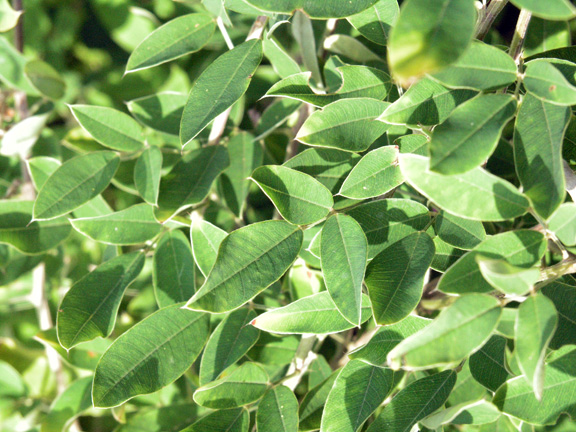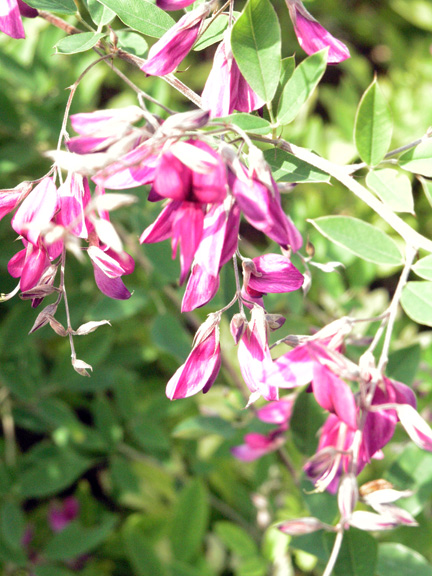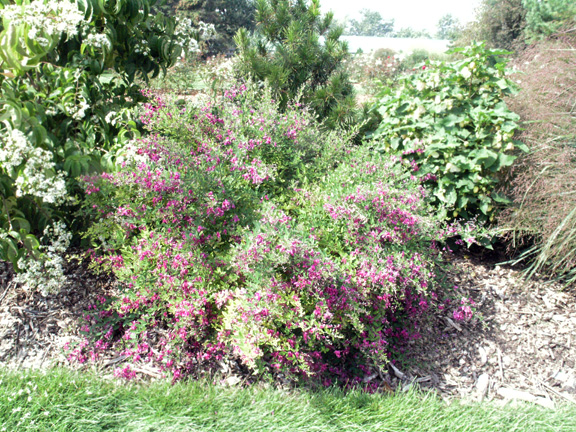
Woody > Lespedeza > Lespedeza bicolor > Lespedeza bicolor
Lespedeza bicolor
Shrub Bushclover
Origin: Japan, Northern China and Korea.
Mike's
Opinion


"
This shrub is often considered a weed or invasive species. However there are many benefits that counter the few negatives about the plant. It provides food for animals and allows bees to forage longer into the season and thus able to produce more honey a year. If properly maintained this shrub can be very beneficial and not become aggressive.
Michael Pascoe, NDP., ODH., CLT., MSc. (Plant Conservation)
"
| Family |
| Fabaceae |
| Genus |
| Lespedeza |
| Species |
| bicolor |
| Category |
| Woody |
| Type |
| Shrub (deciduous) |
| Pronunciation |
| USDA Hardiness Zone |
| 4-8 |
| Canadian Hardiness Zone |
| 6b-4a |
| RHS Hardiness Zone |
| H5-H7 |
| Temperature (°C) |
| -25 - (-10) |
| Temperature (°F) |
| -30- 20 |
| Height |
| 3 m |
| Spread |
| 3 m |
Photographs
Description and Growing Information
Flowering Period
| General Description |
| A medium sized, shrub with multiple stems and small flowers. The branches are not as cold tolerant as the root and crown. It was introduced to North America in the late 1800s. |
| Landscape |
| Used as a border, hedge planting, wind break and in erosion control. Provides food and shelter to game animals, such as white-tailed deer, rabbits, gophers and bobwhite quail. Beekeepers often use this plant for honey production due to its extended flowering period. |
| Cultivation |
| Any moist soil with a pH level of about 6.5 in full to part sun. The plant should be cut back every year before winter. |
| Shape |
| Upright, stems bow downward when the flowers bloom due to the increase in weight. |
| Growth |
| Fast |
| ID Characteristic |
| The small, purple flowers bloom throughout most of the summer season. It is able to fix atmospheric nitrogen because of its compatibility with a soil bacteria that attaches to the shrubs root system. |
| Pests |
| There are no serious problems with disease. The Japanese beetle has a minor effect on the shrubs leaves, flowers and flower buds, however the damage caused by the beetles is not fatal to the plant. |
| Habitat |
| Open areas, such as old fields, thickets, savannah, prairies, pine forests and woodlands where ample sunlight reaches the ground. It is also found in parks, along creek banks and highways |
| Bark/Stem Description |
| Grey to green in colour with a smooth surface. In winter the bark turns brown with an occasional purple tint on one side. |
| Flower/Leaf Bud Description |
| Reddish in colour with fine lines. Where the bundle scars are obscured from view, the leaf scars are raised. There are often collateral buds present near auxiliary buds. |
| Leaf Description |
| Alternate, trifoliate, obovate leaflets, middle leaflet is larger in size and has a longer petiole than the other two leaflets. The leaves are dark green in colour with a paler underside. Can be smooth or slightly covered with short hairs on both sides. |
| Flower Description |
| 5-13 cm long racemes with 5-15 pink to purple, pea-like flowers. The flowers appear on the upper portion of the stem from the leaf axils. |
| Fruit Description |
| .85 cm long, single seed pods with a soft texture and ovate shape. The pods are flat and need to be eaten and passed through an animal or decaying to release the seed. |
| Colour Description |
| The leaves are dark green with a paler underside. They may turn yellow in autumn. The flowers are pink to purple, while the bark is grey-green and the fruit is green in colour with black seeds. |
| Texture Description |
| Medium. The leaves are fuzzy, while the bark is smooth. |
| Notable Specimens |
| The A. M. Cuddy, Gardens. Strathroy, Ontario, Canada. |
| Propagation |
| By seed in soil with good ground moisture and soil pH of about 6.5 for best results. Some scarification, either by soaking in hot water or an 8-15 min acid treatment is needed to soften the seed coat. Plant seeds at a depth of 1.3-2.5 cm in mid-spring in a clear firm seed bed with a growing season of at least, 60 days. If the soil is erosion or drought prone, add a mulch of straw or wood fibres. The flowers are perfect but self-sterile and are most often cross pollinated by bees. For annual care apply 45-90 kg of 0-20-20 fertilizer, depending on size and number of plants. |
| Ethnobotanical Uses (Disclaimer) |
| Oil made from the seeds can be used as a lubricant. Tea can be made from the leaves. Baskets have been made by weaving the branches. All parts of the shrub can be cooked and eaten. |
References
Hiller. (1973). Hiller's Manuel of Trees & Shrubs. Cranberry, New Jersey: A.S. Barnes & Co., Inc.
Dirr, M.A. (2011). Dirr's Encyclopedia of Trees & Shrubs. Portland, Oregan: Timber Press, Inc.


